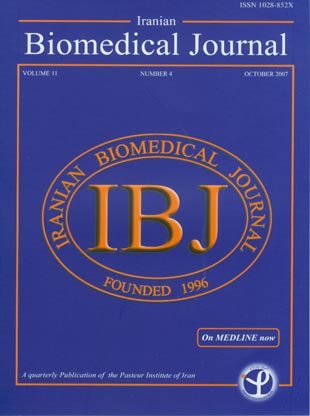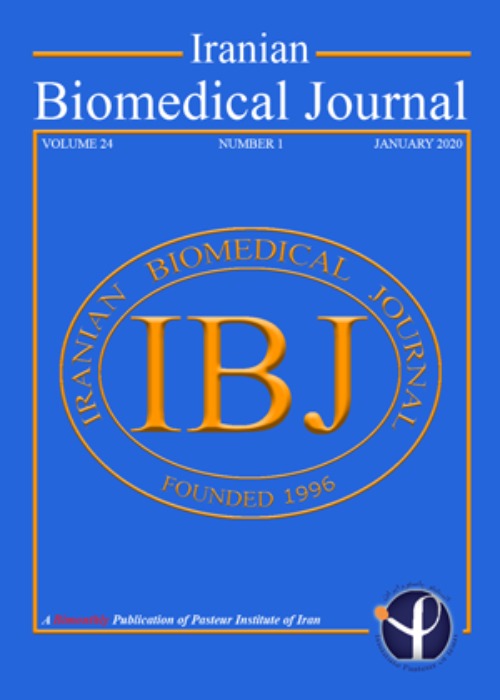فهرست مطالب

Iranian Biomedical Journal
Volume:11 Issue: 4, Oct 2007
- 70 صفحه،
- تاریخ انتشار: 1386/09/30
- تعداد عناوین: 8
-
-
Page 215BackgroundDendrostellera lessertii (Thymelaeaceae) is a toxic plant that grows in parts of Iran. The anti-proliferative properties of its crude methanol extract and one of its active components, 3-hydrogenkwadaphnin (3-HK), have been established using several cancer cell lines.MethodsIn a further attempt to determine the mode of action, two groups of synchronously growing cells were treated with a single dose of 3-HK (3.5 nM) and/or a single dose of the crude extract (equivalent to 0.36 mg plant powder). Every 8 hours, the percentages of cells within G1, S, and G2-M phases were determined by flow cytometric (FCM) analysis; electron microscopic pictures were taken after fixation with 2% glutaraldehyde.ResultsTwelve hours after treatments, apoptotic cell death was confirmed by the observation of marked morphological changes of the plasma membrane as microvillar disappearance and the appearance of apoptotic bodies in the treated cells. FCM analyses revealed that the G1 phase arrest was under the influence of the pure substance.ConclusionThe results confirmed the previously drawn conclusion that the raw material and the pure substance from D. lessertii exert their anti-tumor effects through cell cycle arrest at G1 phase and diversion of cell fate toward programmed cell death. Iran. Biomed. J. 11 (4): 215-221, 2007
-
Page 223BackgroundAlthough pyrimethamine (Tindurin™) appears to be effective in the prevention and treatment of some infectious diseases, very little information exists on its unpredictable properties. We design this study to evaluate its anti-tumoral effect on a model of cell line.MethodsThe cytotoxic influence of Pyrimethamine on prostate cell line was investigated using an in vitro colometric assay. The potential modulatory effects on metastasis, apoptosis, and immortality characteristics of cells were assessed with gelatin zymography, terminal deoxyribonucleotidyl transferase-mediated dUTP nick-end labeling (TUNEL) assay and telomeric repeat amplification protocol, respectively.ResultsCytotoxicity analysis of pyrimethamine revealed a dose- dependent fashion. An apoptotic influence of pyrimethamine was also confirmed by data obtained from TUNEL assay. Dose-dependent inhibitory effect on matrix metalloproteinases (MMP) was seen in pyrimethamine. A potent inhibitory effect of pyrimethamine was also established by data achieved from TRAPeze telomerase detection kit.ConclusionsCollectively, as induction of apoptosis together with MMP and telomerase inhibition could be indicative of cancer treatment, pyrimethamine might be considered as a chemopreventative agent in cancer. Iran. Biomed. J. 11 (4): 223-228, 2007
-
Page 229BackgroundMeasles virus (MV) is a highly contagious agent which causes a major health problem in developing countries. We studied the effect of buthionine sulfoximine (BSO) on the replication of an AIK-HDC strain of MV and its induced apoptosis in Vero cell lines.MethodsIn this study, toxicity of BSO on Vero cells was investigated first, resulted in determination of sub-lethal or non-toxic concentration zone of BSO for cells. Next, anti-viral effect of BSO at various time limits was evaluated and virus titer was determined at each stage either as 50% tissue culture infective dose (TCID)50 or by plaque assay method. Using specific anti-measles IgG, anti-viral effect of BSO on MV replication cycle was evaluated through indirect immunofluorescence assay, meanwhile presence of viral RNA was investigated by RT-PCR and gel electrophoresis.ResultsAccording to the experiments, BSO, at concentration of 50 μM, markedly inhibited the cytopathic effect (CPE) induced by MV. BSO also significantly inhibited apoptosis induced by MV. BSO either influences replication of MV genome, or may inhibit virion formation.ConclusionThese results suggest that the inhibition of CPE and apoptosis by BSO induced by MV may be associated with the effect of BSO on viral RNA genome. Therefore, it is suggested that MV infections can induce apoptosis through the activation of a common pathway that can be inhibited by BSO Iran. Biomed. J. 11 (4): 229-235, 2007.
-
Page 237BackgroundProgressive cognitive decline is one of the hallmark symptoms of Alzheimer’s disease (AD) which can be modeled by β-amyloid injection into specific regions of brain. Since epigallocatechin-3-gallate (EGCG) is a potent antioxidant agent which its role against oxidative stress and inflammation has been shown in prior studies, we tried to determine whether EGCG administration protects against β-amyloid-induced memory and coordination impairment in rats.MethodsAnimals (male Wistar rats) were divided into four groups: sham operated, EGCG-pretreated sham operated (sham + EGCG), untreated lesion (lesion), and EGCG-pretreated lesion (lesion + EGCG). Animals in lesion, lesion + EGCG, and sham + EGCG groups received sterile saline or saline plus EGCG (10 mg/kg) intraperitoneally one day pre-surgery and every other day for three weeks. The lesion was induced one day after EGCG pretreatment by injection of 4 µl of sterile saline or water containing 2 nmol/µl β-amyloid (1-40) into the hippocampal fissure. For behavioral analysis, psychomotor coordination (PMC) index and spontaneous alternation behavior were assessed using Rota-rod Treadmill and Y-maze, respectively at the third week post-lesion.ResultsWe found that β-amyloid (1-40) injection into hippocampus can decrease these behavioral indexes in lesion group in comparison with sham group which is similar to behavioral changes in AD. On the other hand, pretreatment with EGCG can improve the PMC index and spatial Y-maze alternation in the lesion + EGCG group in comparison with lesion group.ConclusionWe concluded that EGCG can be effective in restoring β-amyloid-induced behavioral derangements in rats regarding coordination and memory abilities. Iran. Biomed. J. 11 (4): 237-243, 2007
-
Page 245BackgroundThe purpose of this study was to evaluate the efficiency of intracytoplasmic sperm injection (ICSI) and Piezo-assisted sperm injection after pretreatment with calcium ionophore (CaI) on the mouse embryo development.MethodsIn this study, the conventional ICSI and Piezo-ICSI procedures were used. The efficacy of the methods was examined after mouse matured oocytes were fertilized with or without CaI-treated sperms.ResultsPiezo-ICSI demonstrated significantly more favorable results, with a fertilization rate of 64% (conventional ICSI: 42%, P<0.001) and a cleavage rate of 73% (conventional ICSI: 58%, P<0.05). When the Piezo-ICSI procedure was performed with CaI-pretreated sperms, the cleavage rate significantly increased (92% vs. 73%, P<0.05). However, the fertilization rate did not change significantly (64% vs. 56%).ConclusionThe Piezo-ICSI accompanies with CaI-treated sperms is more efficient than the conventional ICSI method for fertilizing and thus obtaining more mouse embryos. Iran. Biomed. J. 11 (4): 245-250, 2007
-
Page 259BackgroundEvidence supports the involvement of nitric oxide (NO) in a Varity of male reproductive processes such as spermatogenesis, spermiogenesis, sperm motion, sperm metabolism and sperm capacitation. However, Low concentration of NO is essential in biology and physiology of spermatozoa, but high amounts of NO is toxic and has negative effects on sperm functions. On the other hand, it is established that high amounts of NO have detrimental effects on DNA. The integrity of sperm DNA is an important factor in successful fertility and embryo development. It is hypothesized that supra physiological concentrations of NO in seminal plasma cause sperm DNA damage. The aim of this study was to determine sperm DNA damage by comet assay and its correlation with NO level in seminal plasma of fertile and infertile men.MethodsSemen samples were collected from 45 patients and 70 healthy donors. The stable metabolites of NO (nitrite and nitrate) in seminal plasma were measured by Griess assay and DNA damage was determined using single cell gel electrophoresis (comet) assay method.ResultsThe NO concentration in the seminal plasma of infertile males was significantly higher than fertile males (5.74 ± 1.01 μM/L vs. 3.88 ± 0.53 μM/L). There was a significant positive correlation between the NO concentration and sperm DNA comet value in infertile males (P<0.01, R = 0.598).ConclusionThese results indicate that the overproduction of NO in genital tract of infertile males has a potential pathogenetic role in the reduction of sperm DNA integrity. Iran. Biomed. J. 11 (4): 259-264, 2007


